
14 minute read
All
Working Together for the Benefit of Us All
Advertisement
Without doubt the consenting sector is facing one of its biggest challenges in our construction history. There has been a lot of recent comment around timeframes and timeliness of service provisions. But we need to acknowledge the incredibly challenging circumstances over the last couple of years, that more consents have been issued than at any time in our history. The role of building officials in delivering on quality consent needs greater acknowledgement, regardless of the stresses that are still in place. There are many of us in the licensed field who have potential solutions that may expedite quality processing times and allow workflows to improve significantly. These can also assist in mitigating cost impacts of delays. With construction inflation currently running in the region of 18% to 20%, any tools allowing consenting
Tie spacing authorities to proactively address the challenges delivering on quality processing should be looked at. We are all aware that the perfect storm of increased build activity, the Covid 19 impact, supply chain shortages, skill capability limitations, combined with the inability of industry to boost their workforces from overseas, has placed immense pressure on all parts of the building system. Consequently, the Master Brick and Blocklayers has been investing in tools their members can use to assist Building Consent Authorities (BCAs) in significantly reducing review times to approve codecompliant work and keep a visual record of said work for future reference.
The advantages to all parties within the process are significant. Workflows improve for the building community, especially the smaller contractor who may not have enough of a pipeline to be economically comfortable with some of the delays that are now commonplace. Building clients are less likely to be impacted by inflationary delays, and builders and subcontractors cash flows are normalised, providing better protection for smaller businesses and ongoing sustainability. Effectively, if we can assist in expediting the half high approval process it has a similar impact to removing the cork from a bottle, many other tasks flow from this point. The evidential trail a modern appbased evidence system can provide, allows officials to have considerable comfort they can view the appropriate building code factors with confidence. The app-tools provide an ability to confirm the GPS location of the work and that an LBP is providing the evidence from their own device. Video or photographic confirmation of tasks can be appropriately included and completed, showing products used by brand and type. The detail contained within the Master Brick and Blocklayers system collects and provides for a full record of works, that can be viewed or provided to builders, engineers, project managers, and consenting authorities instantly on request. The ability to improve workflows and be part of a solution that eases pressure on consenting officials has from day one been at the core of this system's development. Within the app structure is capability for a full written and
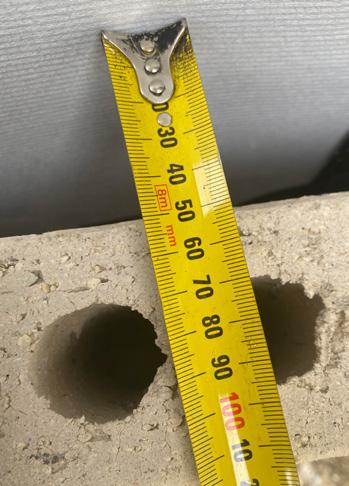
Cavity
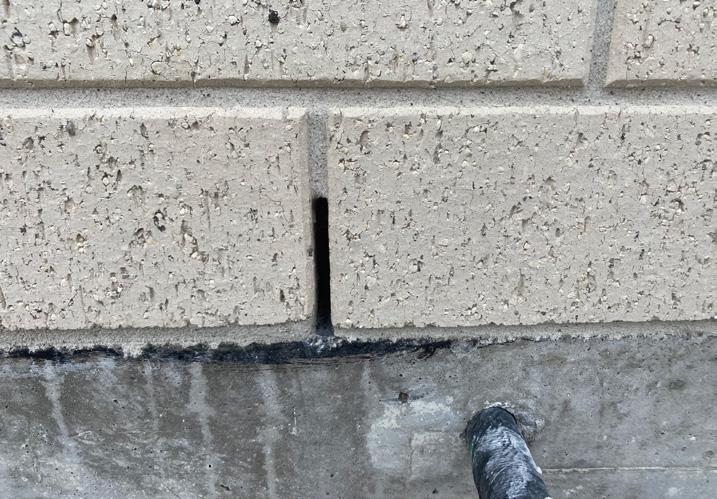
Weephole
visual confirmation that the work being submitted is confirmed by the LBP and complies with the requirements of the appropriate NZ Standards, the Building Code, as well as Master Brick and Blocklayers Best Practice Guides for Brickwork. It achieves this through a comprehensive checklist completed by the LBP. It also has the capability to add the SSSP and Record of Work for the project and can be directly uploaded and sent to the interested parties: e.g., Council, builders, engineers, and owners. The list of inclusions covers site description, confirmation that appropriate consents have been sighted by the contractor, identification of Restricted Building Work (RBW), product details, and site management and environmental controls.
This is followed by set out identifiers with specific pathways for Brick and Block work, that are confirmed by the LBP. These includes matching the consented plan, positioning of damp course, size of overhang, appropriate flashings, sealing of penetrations cavity size (which can be videoed along the expanse of the wall) or photographed as requested, covering of work and product as and where required, control joint methods with photographic support. Tie and Lintel work is also recorded that they align with the consented plans. Weep Holes are appropriate and positioned, aligning with the standards, again with video or photo support being provided. Once the contractor has completed this input, they move on to a completion checklist, which covers: • Straightness and plumb within tolerances, • Angle of sills, • Cleanliness of finished work, • End of work, • Site management completed, • For Brick whether it’s a half high or final filing. Blockwork has its own specific workflow requirements, relating to the steelwork requirements of NZS 4210 and general site safety and best practice. Again, the stages can be recorded and sent directly to all parties in the process. This includes placement of horizontal steel, linking with vertical bars, clean outs, confirmation that the mortar is of the desired strength, pre-pour checks, confirmation that the correct block fill, as specified is used, dimensions, etc, all meet the specifications. The checks within the app flows are very comprehensive. The app is designed to allow the consenting agent to respond to the sender, if clarification via photographic or video evidence is required, and to address any matter they may have questions about. Importantly saving time and travel for all parties involved.
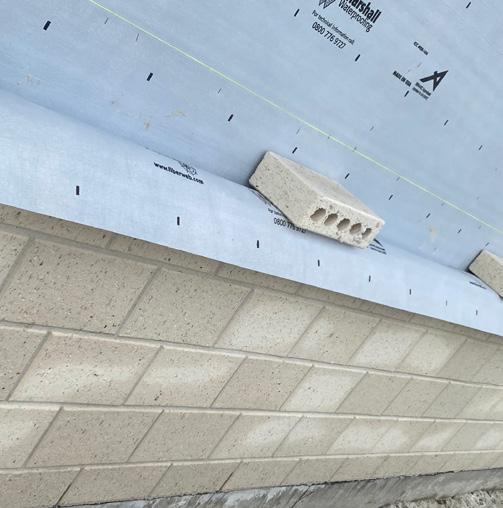
Working together should primarily be about improving outcomes for consumers through collaborative partnerships to the benefit of all. If any consenting authority or group would like a demonstration of the full capability of the App, we are very willing to meet this request, either physically or through a Zoom/Teams type meeting. Master Brick and Blocklayers also have an introductory video outlining the processes and functionality. This can be made available to BOINZ members upon request.
About the writer:
Brian Miller is currently the Chair of Master Brick and Blocklayers and has spent most of his working life in the construction sector, from training as a Joinery Machinist, Window and Door Manufacture, and until recently as the CEO of Master Painters New Zealand.
The opinions expressed in this article are those of the Master Brick and Blocklayers Association.

INTERVIEW
Spotlight on a Member: Daniel Harrison
Daniel Harrison was the recipient of the Emerging Leader Award at the BOINZ 2021 Conference in Wellington. With our annual conference coming up in August, we had a chat with Daniel to find out more about him, what he does and where he has been. Daniel is the Auckland Branch Secretary and currently works as a Team Leader in Project Assessments for Auckland Council.
Before his journey led him into this industry, Daniel started as an apprentice in painting and decorating for two years after leaving High School. During the global financial crisis of 2007/08 which affected the painting business, Daniel was let go, but an opportunity to study Theology arose, talk about a silver lining! Daniel packed up his bag and hit the road from Wellington to Auckland.
Q. Tell us about your career pathway into the wider industry?
In 2009 I was successful enough to enter the cadetship programme collaboration between the Manukau City Council and the Ministry of Social Development. While the programme was only nine months long, I met some wonderful people who are still in Council today, and in Kotuku House which is ironically where I have ended up! My duties included mostly front-of-house and customer services.
Part way through the programme I started working part-time in the call centre. I was back and forth between the teams, but it was a real eye-opener! There were some interesting calls and some customers. I didn’t really know much about Council except for parking tickets and rates, but during the small stint on the job, I knew this was where I wanted to be.
As my time was coming to an end with my cadetship, my team leader in customer services put me in touch with another team leader based at the former Auckland City Council (ACC) for a similar role to what I was doing. This all happened two to three weeks out from wrapping up! I then progressed to ACC into a team that dealt with more than just customer service. My first day was a baptism of fire, my former team leader and I still joke about that to this day. I do not recall taking a lunch break that day, but it was the best way I could have learned in how things worked in my new team. The team also produced LIM reports and property file products. I built my understanding of both building legislation and RMA during that time. I only lasted a year because ACC along with other legacies were to merge to become Auckland Council in November 2010. My time there set me up for my first technical role as a Code Compliance Certificate (CCC) assessor. I give credit to Christine Watkinson, my team leader at the time who took the time to train me and teach me so much about building legislation. A few years into the CCC Assessor role, I was fortunate to be given an opportunity to undertake the Diploma in Building Control Surveying to fulfil my reg 18 obligations., I enjoyed the processing segment which made me jump over from CCC to processing which I have been doing
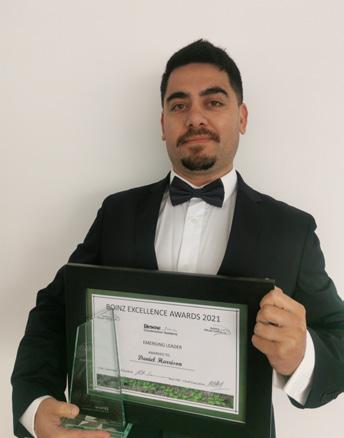
to this day. In the past two years, I have been promoted to the Team Leader position in processing. Not bad for someone who never really finished school!
When I became a BOINZ member in 2012, I became more inquisitive and passionate about what we do as a regulatory service. Since then, I have been encouraged to take up office as a branch executive.
Q. What are the major changes you have seen in the past 10 years in relation to BCOs and study?
I think there is a bit more support for people like myself who want to enter the role of regulatory service. Back then it was more about who you knew. The training was not as serious as it is now, I think there is a real need for staff to train because there are so many legislation changes, and product systems being introduced into the market. We have no excuse for not preparing our staff with the same power and knowledge as you would with others on the list of five key responsibility holders. You have the owner, the builder, the designers and architects and product manufacturers. The BCA sits in there so we should have equal rights to knowledge in terms of the value we can input into our consenting and the build process.
Q. What is your approach to facing industry challenges?
Having those genuine conversations. Saying this is our part to play, take responsibility for that and ensure that we work together to find solutions to ensure the best outcome for the customer rather than pointing the finger at each other. We need to focus on building relationships more and expose the truth in all our doing We need to ask ourselves does it have a benefit and does the cost outweigh the benefit? We need to know what the intent is behind it. What will it deliver and how will it be delivered? These are the conversations that never really come about as often as they should. Q. How do you deal with work challenges including working from home, so work doesn’t encroach on family life?
Good question! I make it a habit to turn off from work at a time in the day. Another habit is to take regular breaks during the day, get away from the desk, stretch the legs, get some fresh air, hang out some washing, or empty the dishwasher. Helps to keep you in check, as much as I love my job and want to do more, there is only so much time during one’s day. With my staff, I have calendar appointments booked to catch up with at least one person through a phone call or a message each week. This hasn’t been as regular as usual, but I would like to think that
my team knows that I have time for them. Whether they engage with me or not, the opportunity is there.

Q. From your experience, where do you see our industry heading?
Good question, I hope it heads in a good direction towards sustainability. Can we also make sustainable choices and houses that are not just warmer but smarter too?
In my lifetime I would like to think that legislation might become more compatible – RMA & BA rather RMA vs. BA – and that our approach to development is more inclusive than divided e.g., planners have their job but no consideration of impacts upon building officers etc. I hope we can become smarter in the way we handle the consenting process with it being simplified and easier to understand, not just for us but for the customer too.
In terms of consenting, I would like to see a huge overhaul in the way we do things, case in point, RMA reform and the building act reform. For too long there have been two different legislations. One impacts another, but we cannot combine them together which confuses our customers.
With the number of houses, we are producing, we should have
considered the bigger picture. Let’s get together and work through this whole consenting process and give them one or two consents out of the five they currently need.
Q: What are you excited about in the future?
The prospect that the next generation can make an impact on change if I continue to play my part. I’m excited to see where the direction of the regulatory service is heading and know that we’re in good hands when BOINZ has some involvement.

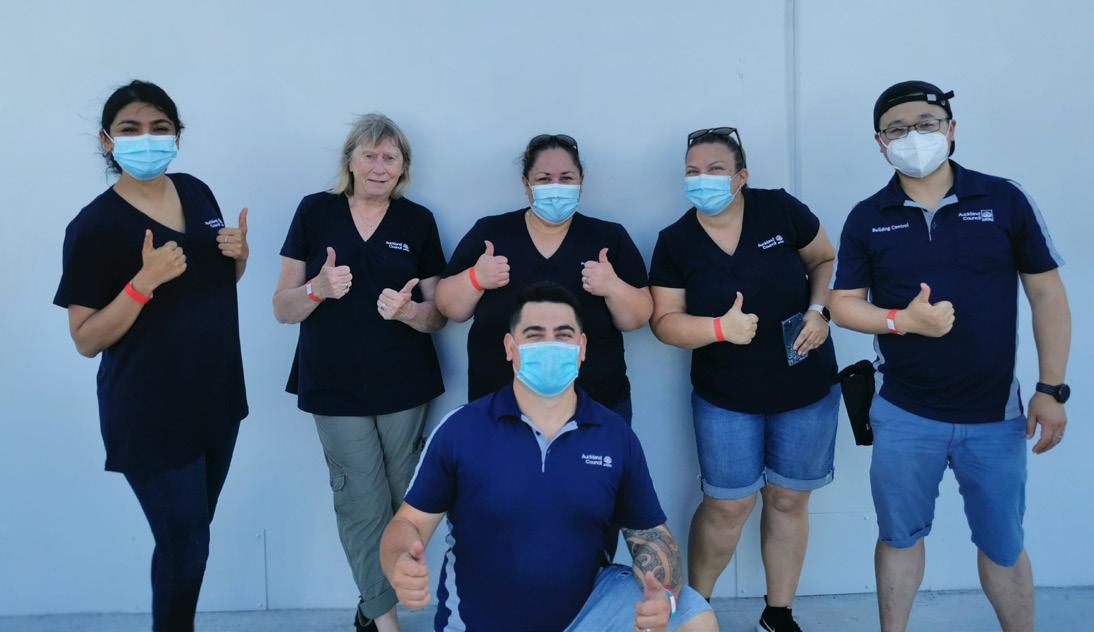
Q: What advice would you give someone looking to start their Building Control career?
Firstly, I was taught as a young man to remain humble! Your humility can really shape your perspective on how you see people and their circumstances. There has got to be a time when you are wrong, and you must apologise for that. What is not okay is when you apologise for no reason, that’s not humility. The humility I am talking about is when you can listen to someone’s opinion and consider what they are saying instead of thinking “I know it all” that won’t get you far in my opinion. The second piece of advice is to stay teachable or adaptable. Change is inevitable, we are always going to encounter change whether we like it or not. We can either understand it, learn from it, or see how we can play a part in it, rather than do the opposite. Mindsets change, management change, what we can do is go with the change and own some of that. start the conversation. It is great being a part of it and seeing the members being really engaged. One of my favourite whakatauki (proverb) is: He aha te mea nui o te ao? he tangata, he tangata, he tangata What is the most important thing in the world? It is the people, it is the people, it is the people.
Q: What is your advice to someone who may want to be on the branch executive?
You will never know the extent of your capabilities until you are thrown into the deep end. The branch executive role doesn’t have a job description. People assume the role could be bigger than what it is.
You always have support from the team, plus, you have a National office I can’t take all the credit. It is not scary at all. Like I said you won’t know what you are truly made of until you pursue it. The branch chairs and secretaries are there to support you, and we are already supported by BOINZ. Chat to anyone at your branch and just Q: Do you have any final words?
Shout out to the Auckland branch’s past executives for what they have done and allow me to continue today. If it weren’t for them, we would not have the strong membership we do. Branch meetings are like a tree of knowledge where we can pick its fruit.
We would like to thank Daniel Harrison for being in the spotlight. Do you know a great candidate for Spotlight on a Member? Please email marketing@boinz.org.nz










